On the Architecture of Systemology and the Typology of Its Principles
Abstract
:1. Systemology: Its Rise and Challenges
2. The Need for a Stronger Systems Science
“It is therefore important to develop a scientific foundation that helps us to understand the whole rather than just the parts, that focuses on the relationships among the parts and the emergent properties of the whole. This reflects a shift in emphasis from reductionism to holism. Systems Science seeks to provide a common vocabulary (ontology), and general principles explaining the nature of complex systems”.[17]
“It seems legitimate to ask for a theory, not of systems of a more or less special kind, but of universal principles applying to systems in general. In this way we come to postulate a new discipline, called General System Theory. Its subject matter is the formulation and derivation of those principles which are valid for ‘systems’ in general”.[20]
3. What Are Systems Principles?
4. Status of Systems Science
5. The Nature and Scope of Systems Science
- First, given that systems occur on every level of the complexity hierarchy, a science of systems must be about what is true of or possible for systems across all the levels. This is the insight behind the claim that system science will be a transdiscipline, having relevance across the disciplinary spectrum, and will comprise theories that are scale-free and composition-independent. At a minimum, such a science must involve concepts and principles that allow systems to be characterised as a category of analysis distinct from things that are not systems, to enable instances of systems to be identified in the real world, and to explain/predict the behaviour and potential of systems as systems. Our present notions of “systemhood” are far from settled, but there is a rich literature on the subject [3,46,47,48,49] (see also footnote 3) and important efforts are under way to consolidate these ideas [39,50].
- Second, when looking across the levels we find similar patterns recurring across multiple levels, e.g., spiral forms in certain tropical storms, sea shells, flowers, and galaxies. Other examples include Fibonacci sequences and Zipf’s Law regularities in natural phenomena [51,52,53]. Speaking metaphorically, these patterns represent solutions to design problems that systems must solve in order to create enduring complex structures. The existence of these isomorphically-recurring patterns across changes in scale and composition entails that there must be transdisciplinary specialised systems principles reflecting the nature of these “solutions”. In principle each of these patterns can be “decoded” to establish a theory that explains the nature and function of the observed pattern, and to identify the relevant explanatory principles. Each such theory would then be a specialised systems science theory, and we have several of these already (e.g., control theory, hierarchy theory, network theory, communication systems theory, theory of dissipative structures, etc.). There are still many patterns in nature we do not theoretically understand, for example patterns of overlapping Fibonacci spirals, and Zipf’s Law patterns. Moreover it is likely that there are further patterns we have not yet identified.
- Third, the isomorphically-recurring patterns arise independently in multiple contexts involving different scales, compositions, and developmental histories. This suggests that there are general systems principles that provide for the possibility of the emergence of these systemic patterns across contexts. Speaking loosely, these would be general principles about how Nature “finds” solutions, rather than (as above) specialised principles about how specific kinds of solutions work. We have very limited knowledge of such general systems principles5, but, in principle, they hold the promise of a general theory of systems that would explain both the emergence of specialized patterns and the relationships between them. Such a “general systems theory” (GST) would be very valuable not only for unifying the body of specialised systems knowledge but also for opening up new routes to discovery, just as Mendeleev’s periodic table of elements did for Chemistry and Darwin’s theory of natural selection did for biology.
6. The General Architecture of Disciplinary Fields
7. Connection to the Systems Perspective
8. Types and Sub-Types of Principles
- i
- what things are like (how they look/behave, what they do);
- ii
- how things work;
- iii
- why they work as they do;
- iv
- how they develop (come about as instances); and
- v
- how they arise in evolutionary history (come about as kinds).
- i
- classification principles;
- ii
- design principles;
- iii
- optimality principles;
- iv
- developmental principles; and
- v
- emergence/evolutionary principles.
- i
- design conceptualization principles;
- ii
- functional design principles;
- iii
- design optimization principles;
- iv
- manufacturing/production principles; and
- v
- innovation principles.
- i
- Reflection, research, design, or intervention principles. This is the major division, but afterwards they can be subdivided as needed into:
- ii
- General or specialized principles;
- iii
- Heuristic or scientific principles; and
- iv
- Ontological, metaphysical, epistemological, cosmological, axiological, or praxeological principles.
9. Conclusions
Acknowledgments
Conflicts of Interest
References
- Ackoff, R.L. Science in the Systems Age: Beyond IE, OR, and MS. Oper. Res. 1971, 21, 661–671. [Google Scholar] [CrossRef]
- Pouvreau, D.; Drack, M. On the history of Ludwig von Bertalanffy’s “General Systemology”. And on its relationship to cybernetics, Part 1. Int. J. Gen. Syst. 2007, 36, 281–337. [Google Scholar] [CrossRef]
- Von Bertalanffy, L. An Outline of General System Theory. Br. J. Philos. Sci. 1950, 1, 134–165. [Google Scholar] [CrossRef]
- Von Bertalanffy, L. General System Theory: Foundations, Development, Applications, Revised Edition; Braziller: New York, NY, USA, 1976. [Google Scholar]
- Mekios, C. Organizing principles as tools for bridging the gap between system theory and biological experimentation. History Philos. Life Sci. 2016, 38, 1–25. [Google Scholar] [CrossRef] [PubMed]
- Rousseau, D.; Wilby, J.M.; Billingham, J.; Blachfellner, S. A Typology for the Systems Field. Systema 2016, 4, 15–47. [Google Scholar]
- McNeil, D.H. A survey of applied systemology. Syst. Res. 1995, 12, 133–145. [Google Scholar] [CrossRef]
- Fuenmayor, R.; López-Garay, H. The scene for interpretive systemology. Syst. Pract. 1991, 4, 401–418. [Google Scholar] [CrossRef]
- Lineberger, R. Deloitte Study: Cost Overruns Persist in Major Defense Programs—Press Release|Deloitte US, Deloitte United States, 24 October 2016. 2017. Available online: https://www2.deloitte.com/us/en/pages/about-deloitte/articles/press-releases/cost-overruns-persist-in-major-defense-programs.html (accessed on 27 February 2017).
- Flyvbjerg, B. What you should know about megaprojects and why: An overview. Proj. Manag. J. 2014, 45, 6–19. [Google Scholar] [CrossRef]
- Jones, D. 66% of IT Projects Fail. Proj. J. Proj. Manag. 2016. Available online: https://projectjournal.co.uk/2016/02/20/66-of-it-projects-fail/ (accessed on 20 February 2016).
- Award#1645065—EAGER/Collaborative Research: Lectures for Foundations in Systems Engineering. Available online: https://www.nsf.gov/awardsearch/showAward?AWD_ID=1645065&HistoricalAwards=false (accessed on 15 January 2017).
- Krigsman, M. Worldwide Cost of IT Failure (Revisited): $3 Trillion. ZDNet, 10 April 2012. 2017. Available online: http://www.zdnet.com/article/worldwide-cost-of-it-failure-revisited-3-trillion/ (accessed on 27 November 2017).
- Hardy-Vallee, B. The Cost of Bad Project Management; Business Journal; Gallup Inc.: Washington, DC, USA, 2012. [Google Scholar]
- Syal, R. Abandoned NHS IT System Has Cost £10bn So Far. Available online: https://www.theguardian.com/society/2013/sep/18/nhs-records-system-10bn (accessed on 13 March 2018).
- Collopy, P.D.; Mesmer, B.L. Report on the Science of Systems Engineering Workshop. In Proceedings of the 53rd AIAA Aerospace Sciences Meeting, Kissimmee, FL, USA, 5–9 January 2015; American Institute of Aeronautics and Astronautics: Reston, VA, USA, 2015; pp. 1–4. [Google Scholar]
- International Council on Systems Engineering (INCOSE). A World in Motion—Systems Engineering Vision 2025; INCOSE: San Diego, CA, USA, 2014. [Google Scholar]
- Rousseau, D.; Wilby, J.M.; Billingham, J.; Blachfellner, S. Manifesto for General Systems Transdisciplinarity (GSTD). Presented at the 59th Conference of the International Society for the Systems Sciences (ISSS), Berlin, Germany, 4 August 2015. [Google Scholar]
- Wilby, J.M.; Rousseau, D.; Midgley, G.; Drack, M.; Billingham, J.; Zimmermann, R. Philosophical Foundations for the Modern Systems Movement. In Systems Thinking: New Directions in Theory, Practice and Application, Proceedings of the 17th Conversation of the International Federation for Systems Research, St. Magdalena, Linz, Austria, 27 April–2 May 2014; SEA-Publications: Linz, Austria, 2015; pp. 32–42. [Google Scholar]
- Von Bertalanffy, L. General System Theory, General Systems; Article Reprinted in Systems Thinking; Midgley, G., Ed.; Sage: London, UK, 2003; Volume 1, pp. 36–51. [Google Scholar]
- Hitchins, D.K. Putting Systems to Work; John Wiley & Sons: Chichester, UK, 2014. [Google Scholar]
- Mobus, G.E.; Kalton, M.C. Principles of Systems Science, 2015 ed.; Springer: New York, NY, USA, 2014. [Google Scholar]
- Walden, D.D.; Roedler, G.J.; Forsberg, K.J.; Hamelin, R.D.; Shortell, T.M. (Eds.) Systems Engineering Handbook, 4th ed.; Wiley: Hoboken, NJ, USA, 2015. [Google Scholar]
- Augustine, N.R. Augustine’s Laws; Penguin: New York, NY, USA, 1987. [Google Scholar]
- Gall, J. Systemantics: How Systems Work and Especially How They Fail; Pocket Books: New York, NY, USA, 1978. [Google Scholar]
- Senge, P.M. The Fifth Discipline: The Art and Practice of the Learning Organization; Random House: London, UK, 1990. [Google Scholar]
- Maier, M.W.; Rechtin, E. The Art of Systems Architecting, 3rd ed.; CRC Press: Boca Raton, FL, USA, 2009. [Google Scholar]
- Whitney, K.; Bradley, J.M.; Baugh, D.E.; Chesterman, C.W., Jr. Systems theory as a foundation for governance of complex systems. Int. J. Syst. Syst. Eng. 2015, 6, 15–32. [Google Scholar] [CrossRef]
- Katina, P.F. Systems Theory as a Foundation for Discovery of Pathologies for Complex System Problem Formulation. In Applications of Systems Thinking and Soft Operations Research in Managing Complexity; Springer: Cham, Switzerland, 2016; pp. 227–267. [Google Scholar]
- Adams, K.M.; Hester, P.T.; Bradley, J.M.; Meyers, T.J.; Keating, C.B. Systems Theory as the Foundation for Understanding Systems. Syst. Eng. 2014, 17, 112–123. [Google Scholar] [CrossRef]
- Von Bertalanffy, L. General System Theory: Foundations, Development, Applications; Braziller: New York, NY, USA, 1969. [Google Scholar]
- Francois, C. (Ed.) International Encyclopedia of Systems and Cybernetics; Saur Verlag: Munich, Germany, 2004. [Google Scholar]
- Danielle-Allegro, B.; Smith, G. Exploring the Branches of the Systems Tree; Les Editions Allegro Brigitte D: Castelnau d’Estretefonds, France, 2016. [Google Scholar]
- Heylighen, F. Self-Organization of Complex Intelligent Systems: An Action Ontology for Transdisciplinary Integration. Available online: http://pespmc1.vub.ac.be/Papers/ECCO-paradigm.pdf (accessed on 13 March 2018).
- Kramer, N.J.T.A.; De Smit, J. Systems Thinking: Concepts and Notions; Martinus Nijhoff: Leiden, The Netherlands, 1977. [Google Scholar]
- Schindel, W.D. Abbreviated SystematicaTM 4.0 Glossary—Ordered by Concept; ICTT System Sciences: Terre Haute, IN, USA, 2013. [Google Scholar]
- Schoderbek, P.P.; Schoderbek, C.G.; Kefalas, A.G. Management Systems: Conceptual Considerations (Revised Edition); IRWIN: Boston MA, USA, 1990. [Google Scholar]
- Wimsatt, W. Re-Engineering Philosophy for Limited Beings: Piecewise Approximations to Reality; Harvard University Press: Cambridge, MA, USA, 2007. [Google Scholar]
- Sillitto, H.; Dori, D.; Griego, R.M.; Jackson, S.; Krob, D.; Godfrey, P. Defining “System”: A Comprehensive Approach. In Proceedings of the 27th Annual INCOSE International Symposium (IS), Adelaide, Australia, 15–20 July 2017; Volume 27, pp. 170–186. [Google Scholar]
- Rousseau, D. Three General Systems Principles and their Derivation: Insights from the Philosophy of Science Applied to Systems Concepts. In Proceedings of the 15th Annual Conference on Systems Engineering Research—Disciplinary Convergence: Implications for Systems Engineering Research, Los Angeles, CA, USA, 23–25 March 2017. [Google Scholar]
- Calvo-Amodio, J.; Kittelman, S.; Wang, S. Applications of Systems Science Principles. Presented at the Workshop on “Systems Science—Principles for the Evolution of Systems”, International Annual Conference of the American Society for Engineering Management (ASEM) on the theme “Reimagining Systems Engineering and Management”, Huntsville, AL, USA, 18–21 October 2017. [Google Scholar]
- Rueger, A.; McGivern, P. Hierarchies and levels of reality. Synthese 2010, 176, 379–397. [Google Scholar] [CrossRef]
- Poli, R. The Basic Problem of the Theory of Levels of Reality. Axiomathes 2001, 12, 261–283. [Google Scholar] [CrossRef]
- Boulding, K.E. General systems theory—The skeleton of science. Manag. Sci. 1956, 2, 197–208. [Google Scholar] [CrossRef]
- Rousseau, D. Systems Research and the Quest for Scientific Systems Principles. Systems 2017, 5, 25. [Google Scholar] [CrossRef]
- Bunge, M. Emergence and Convergence: Qualitative Novelty and the Unity of Knowledge; University of Toronto Press: Toronto, ON, USA, 2003. [Google Scholar]
- Bunge, M. Ontology II: A World of Systems; Reidel: Dordrecht, The Netherlands, 1979. [Google Scholar]
- Schindel, W.D. What is the Smallest Model of a System? In Proceedings of the INCOSE 2011 International Symposium, International Council on Systems Engineering, Denver, CO, USA, 20–23 June 2011; pp. 99–113. [Google Scholar]
- Ackoff, R.L. Towards a System of Systems Concepts. Manag. Sci. 1971, 17, 661–671. [Google Scholar] [CrossRef]
- Sillitto, H.; Dori, D.; Griego, R.; Krob, D.; Arnold, E.; McKinney, D.; Godfrey, P.; Martin, J.; Jackson, S. What do we mean by “system”?—System Beliefs and Worldviews in the INCOSE Community. In Proceedings of the INCOSE International Symposium, Washington, DC, USA, 7–12 July 2018. Under review. [Google Scholar]
- Friendshuh, L.; Troncale, L.R. Identifying Fundamental Systems Processes for a General Theory of Systems. In Proceedings of the 56th Annual Conference, International Society for the Systems Sciences (ISSS), San Jose State University, San Jose, CA, USA, 15–20 July 2012; p. 23. [Google Scholar]
- Troncale, L.R. Linkage Propositions between fifty principal systems concepts. In Applied General Systems Research; Klir, G.J., Ed.; Plenum Press: New York, NY, USA, 1978; pp. 29–52. [Google Scholar]
- McNamara, C.; Troncale, L.R. SPT II.: How to Find & Map Linkage Propositions for a General Theory of Systems from the Natural Sciences Literature. In Proceedings of the 56th Annual Conference, International Society for the Systems Sciences (ISSS), San Jose State University, San Jose, CA, USA, 15–20 July 2012; p. 17. [Google Scholar]
- Rousseau, D. Strategies for Discovering Scientific Systems Principles. Syst. Res. Behav. Sci. 2017, 34, 527–536. [Google Scholar] [CrossRef]
- Troncale, L.R. The future of general systems research: Obstacles. Potentials, case studies. Syst. Res. 1985, 2, 43–84. [Google Scholar] [CrossRef]
- Troncale, L.R. The systems sciences: What are they? Are they one, or many? Eur. J. Oper. Res. 1988, 37, 8–33. [Google Scholar] [CrossRef]
- Rousseau, D.; Billingham, J.; Wilby, J.M.; Blachfellner, S. In Search of General Systems Theory. Systema 2016, 4, 76–92. [Google Scholar]
- Rousseau, D. A Systematic Framework for Comparing Worldviews. 2018; in preparation. [Google Scholar]
- Rousseau, D. Systems Principles and Worldviews. In Proceedings of the Workshop Presented in the Systems Science Working Group (SSWG) in the International Workshops (IW18) of the International Council on Systems Engineering, Jacksonville, FL, USA, 20–23 January 2018. [Google Scholar]
- Rousseau, D.; Billingham, J.; Wilby, J.M.; Blachfellner, S. The synergy between General Systems Theory and the General Systems Worldview. Systema 2016, 4, 61–75. [Google Scholar]
| 1 | The term “Systemology” was coined by Russ Ackoff ([1], p. 669), and recently promoted by Pouvreau and Drack as an apt translation of the German term, Systemlehre, meaning “an organized body of knowledge about systems” ([2], pp. 282–283). The term Systemlehre was introduced by Ludwig von Bertalanffy in the 1940s. He translated Systemlehre in 1950 as “Systems Theory” and hence his term Allgemeine Systemlehre as “General System Theory” [3], but this was an unfortunate translation choice, as shown by his proposal in 1972 to describe “General System Theory” as embracing “systems science”, “systems technology” and “systems philosophy”, ([4] pp. xix–xxiii). The term “Systemology” is now being widely adopted, e.g., [5,6,7,8], and “General Systemology” has been proposed as a better translation of von Bertalanffy’s term “General System Theory” [2]. |
| 2 | The term “Systems Practice” refers to a professional activity involving the application of “Systems Thinking” to address a problem or pursue an opportunity, typically (but not necessarily) in the context of management science. Systems Thinking is a form of analysis and synthesis that emphasizes systems concepts such as stakeholder, hierarchy, emergence, feedback and boundary. Systems thinking can enter into any phase of a project, e.g., problem structuring, research, design or intervention, but systems practice is the application of systems thinking for the purposes of staging an intervention. In this way Systems Practice involves the selection, deployment and operation of a systemic solution to a given issue. This may (or might not) involve the use of technological products. |
| 3 | It should be noted that systemists have published many statements under the rubric of “general systems principles” or “general systems laws” without these statements being actually useful for making judgements or taking action. These typically are just witticisms or platitudes about systems, such as “today’s problems come from yesterday’s solutions” (Senge), or “complex systems exhibit unexpected behaviour” (Gall). See, e.g., [24,25,26]. Others have published principles that are useful but not general, notably [27], which lists principles for specific contexts such as architecting, design, social systems, and political processes. For summaries of other specialised principles, see also [28,29,30]. |
| 4 | There are very many concepts relevant to systems in the vocabulary of Systemology, e.g., there are 3807 entries in the second edition of Charles Francois’ International Encyclopedia of Systems and Cybernetics [32]. These terms are far from standardised, and hence many systemologists have produced their own lists, e.g., [33], ([34], pp. 21–33), ([35], pp. 11–46), [36], ([37], pp. 13–68), ([38], pp. 353–360). However, very few of these concepts are general systems concepts, i.e., concepts describing universal attributes of systems as systems. |
| 5 | Early work on general systems principles focused largely on general concepts (e.g., ([31], pp. 91, 95)), and while these remain controversial, important progress is now being made (e.g., [39]). In addition, progress is now being made towards establishing propositional general scientific systems principles. Two recent papers respectively presented three such principles [40] and eight strategies for discovery projects [54]. |
| 6 | |
| 7 | For brevity I will gloss over the distinction between methods and methodologies, and for simplicity I will for now ignore the conceptual fields such as Mathematics and Logic. Moreover I will take the sciences to embrace the social and human sciences in addition to the so-called “hard” sciences. For pragmatic reasons I will treat Practice as if it is an integrated field, but of course in reality it is usually presented in academia as disciplinary extensions of specialized disciplines. Nevertheless the practices do fall under common regulatory frameworks, and have similar roles. Likewise for brevity I will here use the term “Philosophy” to refer only to branches of philosophy that adopt the scientific attitude as discussed earlier. |
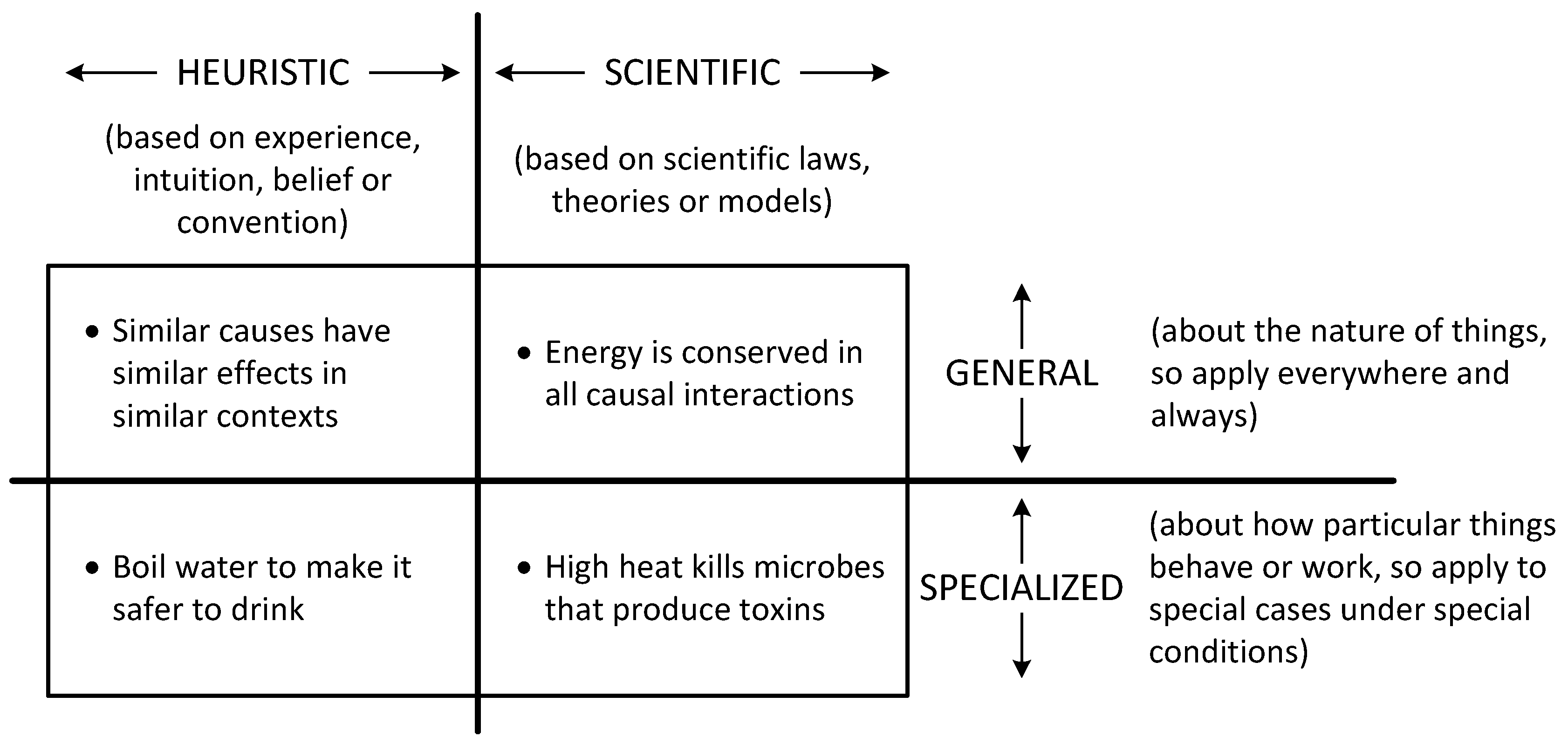
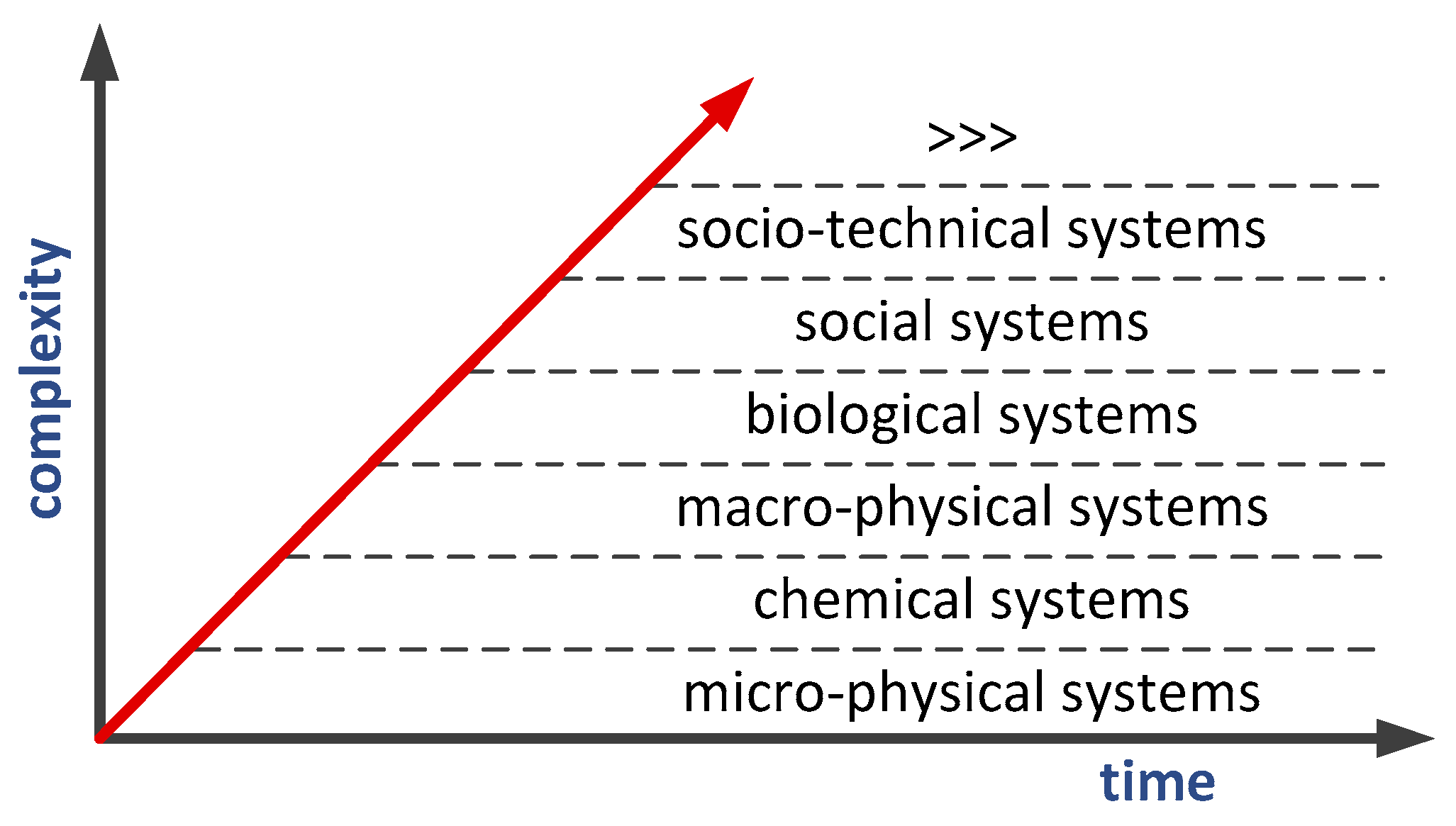



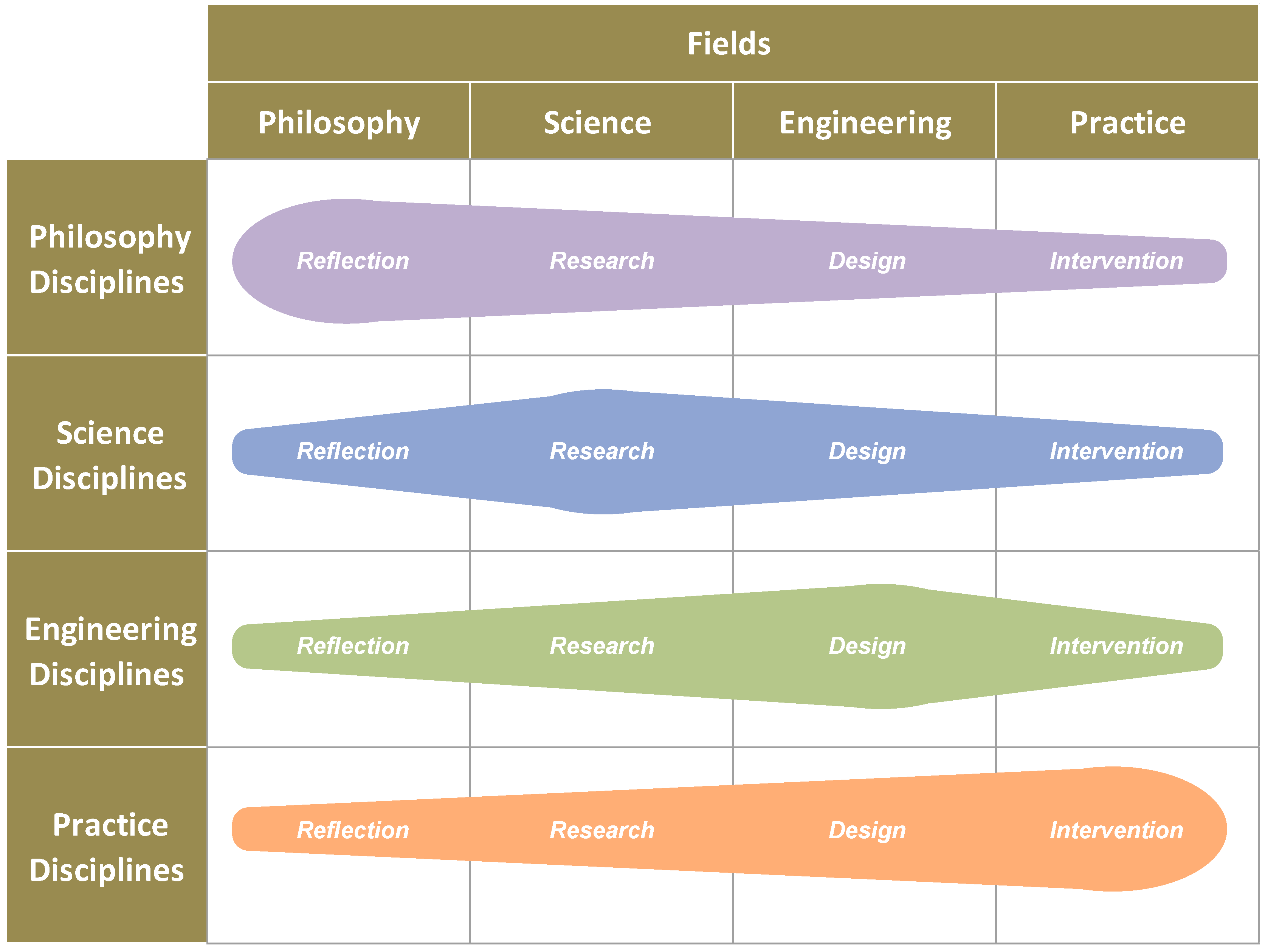
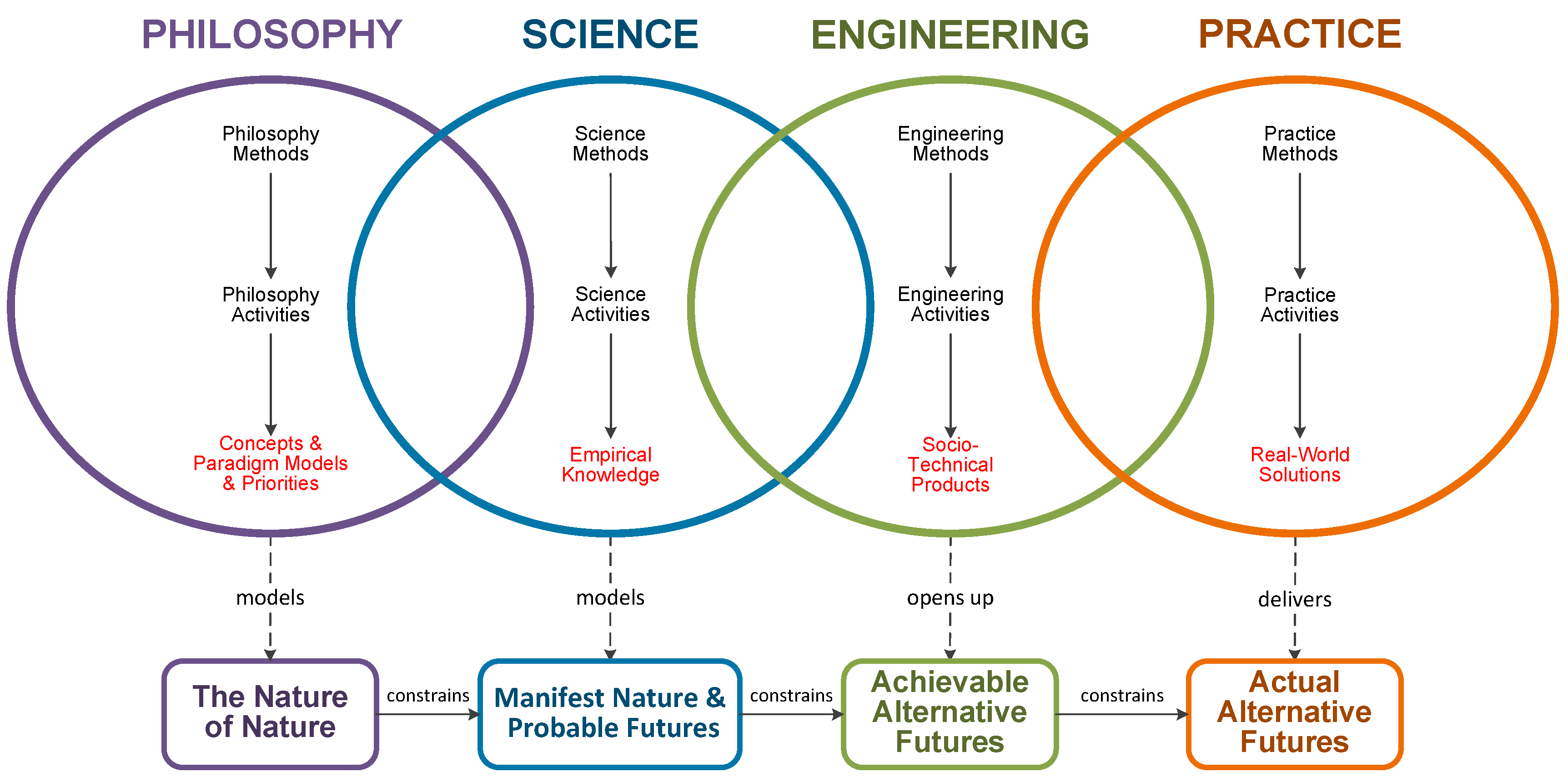
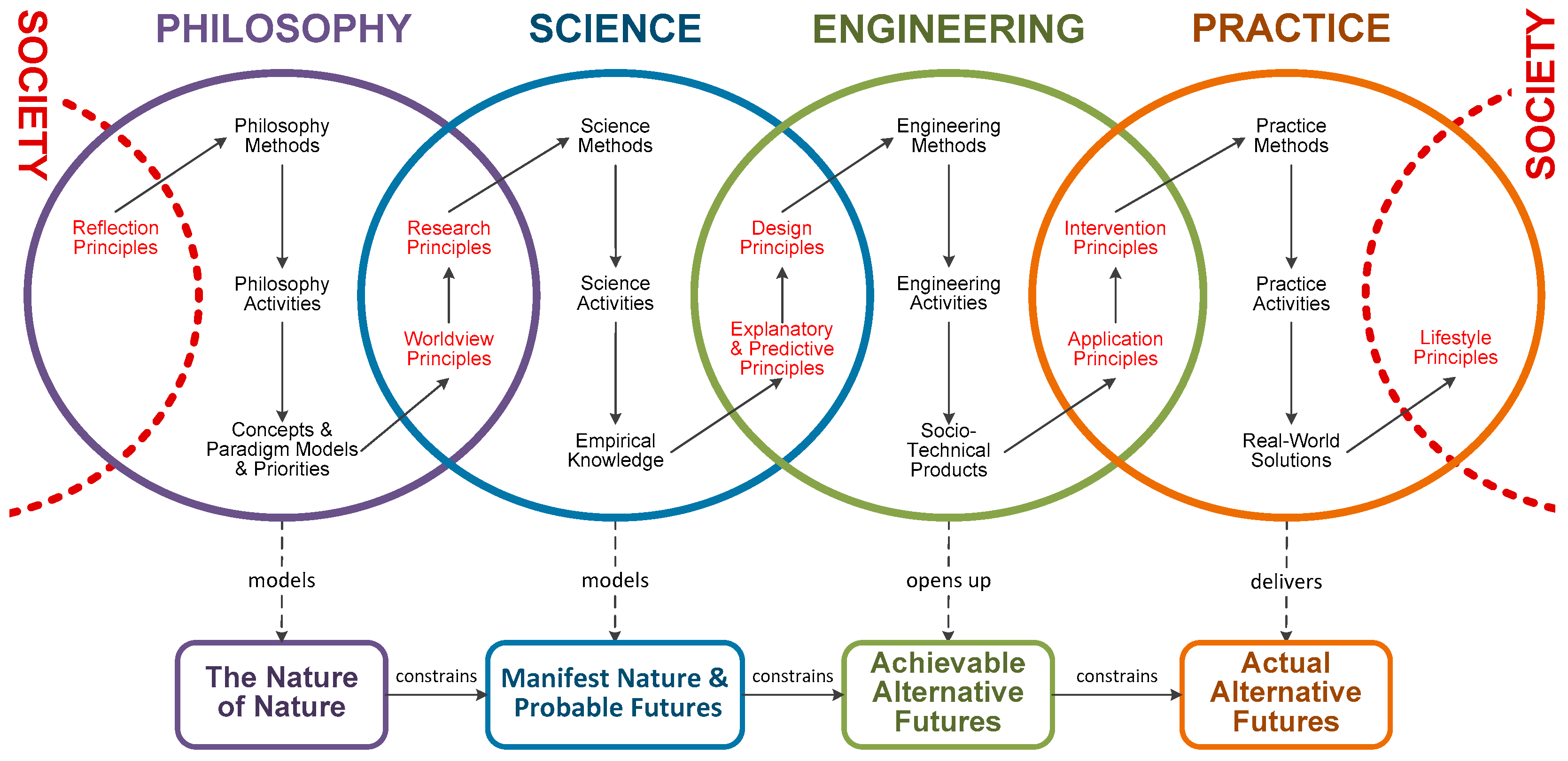
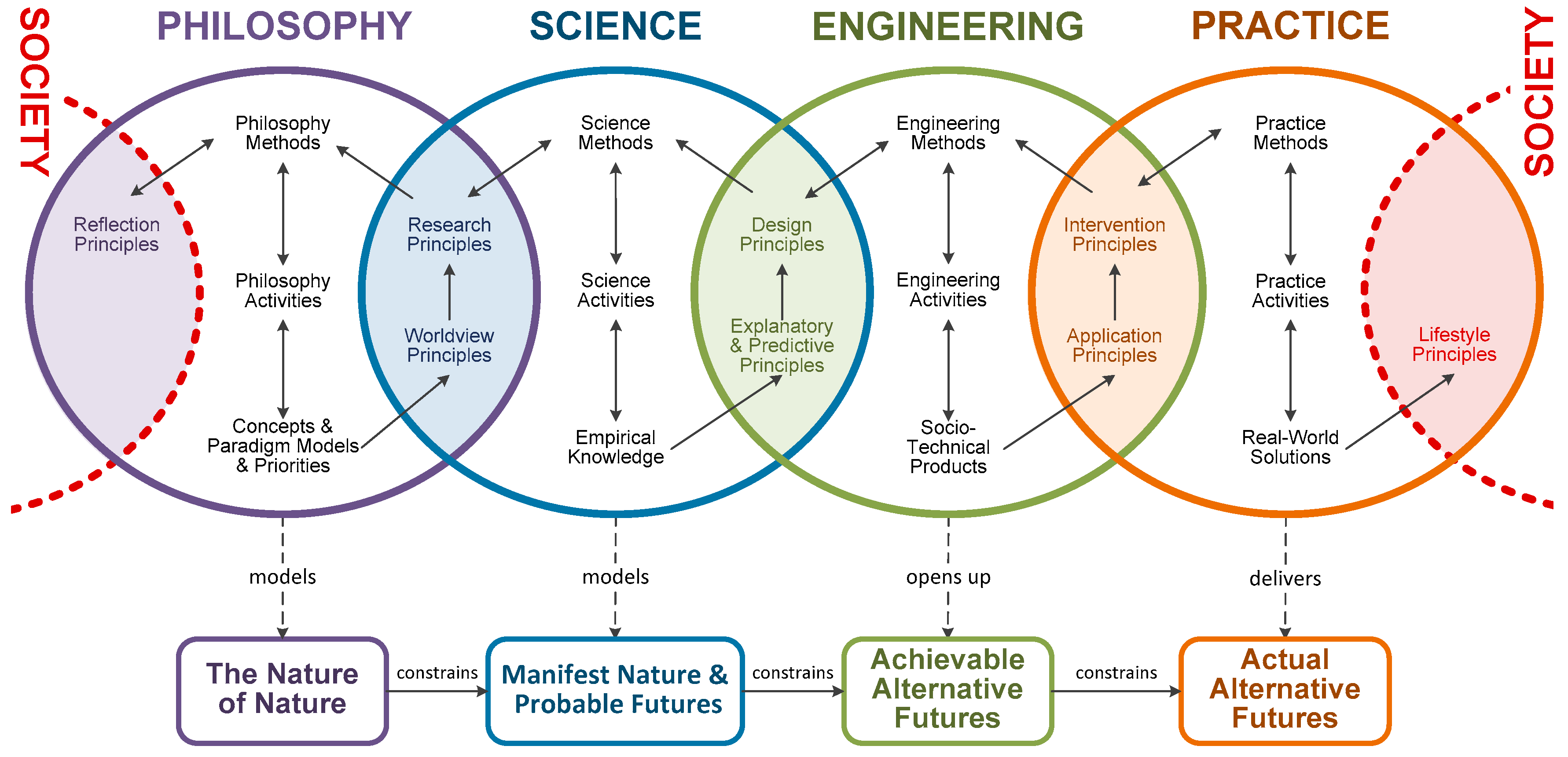

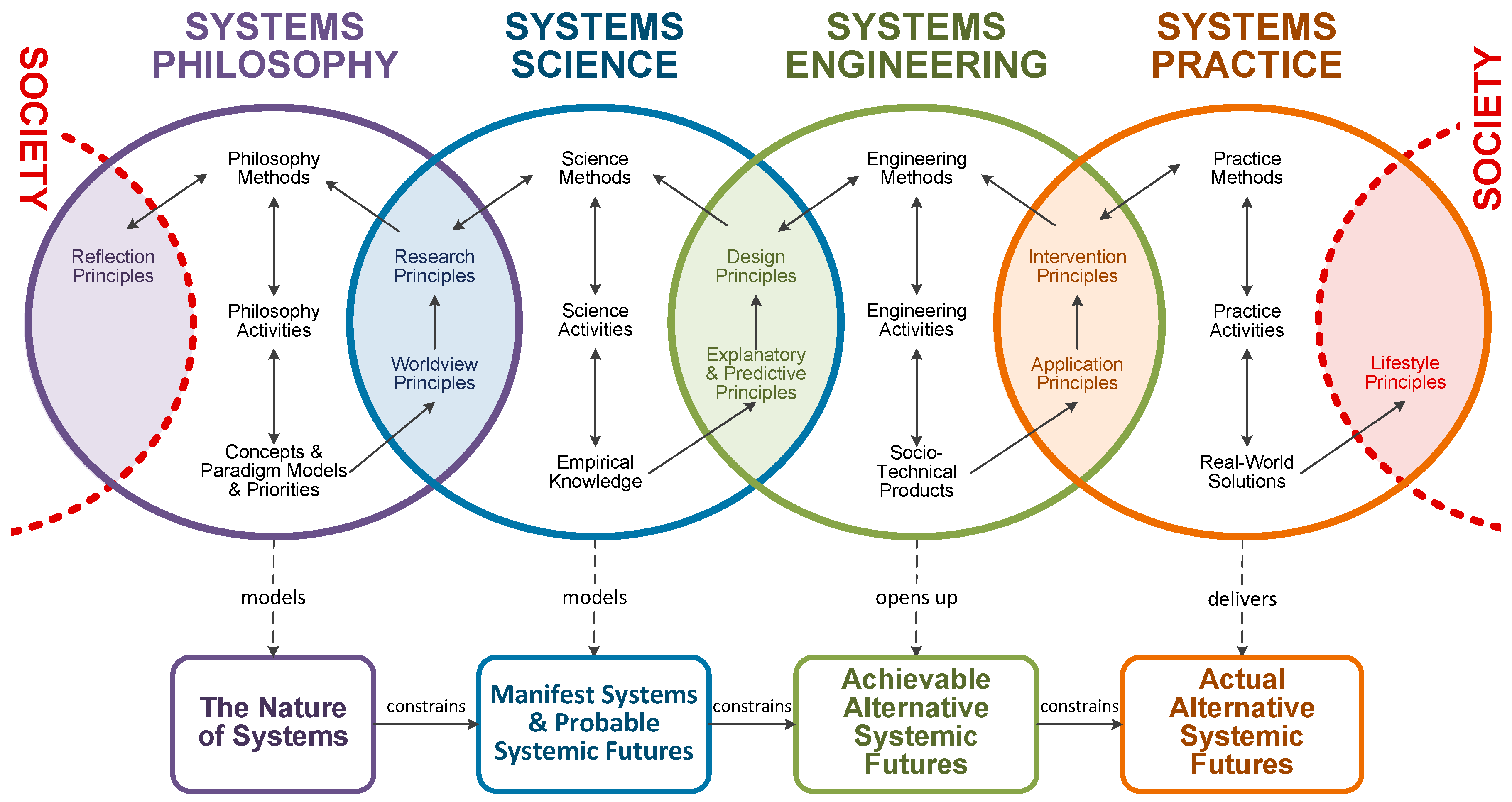
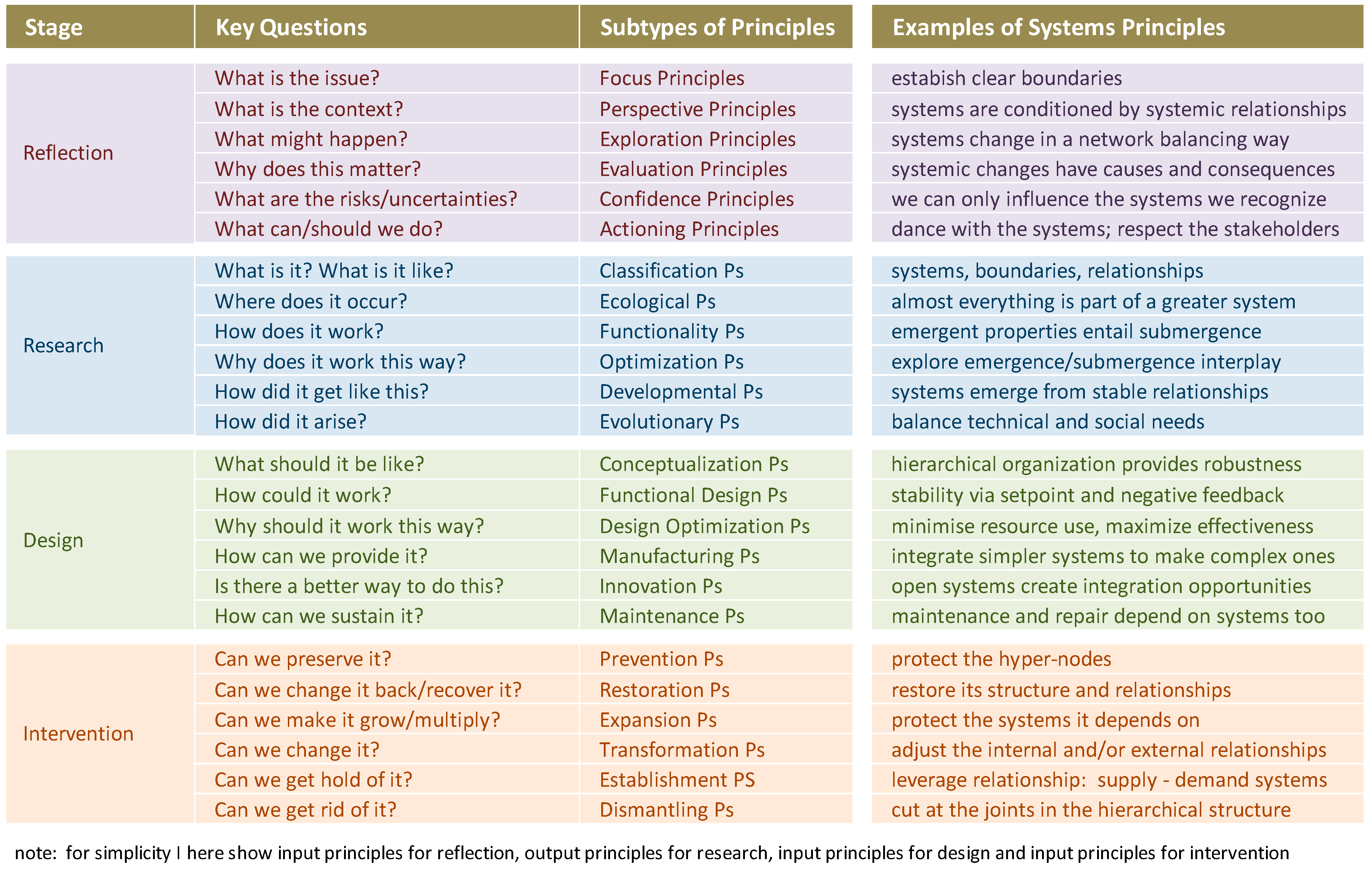
| Worldview Components | Worldview Questions | Research Questions |
|---|---|---|
| Ontology | What exists? | What is it? What is it like? |
| Metaphysics | What is its nature? | What does it do? How does it work? What sustains/degrades it? |
| Epistemology | What/How can we know? | What can we (not) know about it? |
| Cosmology | What is its origin/history/current state/destiny? | How did it get here? How did it get like this? What might happen to it? |
| Axiology | What is important and why? | Why does it work this way? |
| Praxeology | How should we live and why? | How should we (not) study it? |
© 2018 by the author. Licensee MDPI, Basel, Switzerland. This article is an open access article distributed under the terms and conditions of the Creative Commons Attribution (CC BY) license (http://creativecommons.org/licenses/by/4.0/).
Share and Cite
Rousseau, D. On the Architecture of Systemology and the Typology of Its Principles. Systems 2018, 6, 7. https://doi.org/10.3390/systems6010007
Rousseau D. On the Architecture of Systemology and the Typology of Its Principles. Systems. 2018; 6(1):7. https://doi.org/10.3390/systems6010007
Chicago/Turabian StyleRousseau, David. 2018. "On the Architecture of Systemology and the Typology of Its Principles" Systems 6, no. 1: 7. https://doi.org/10.3390/systems6010007




